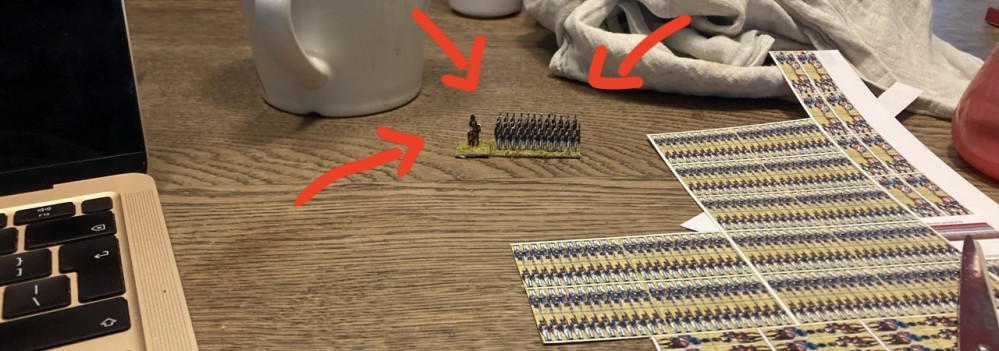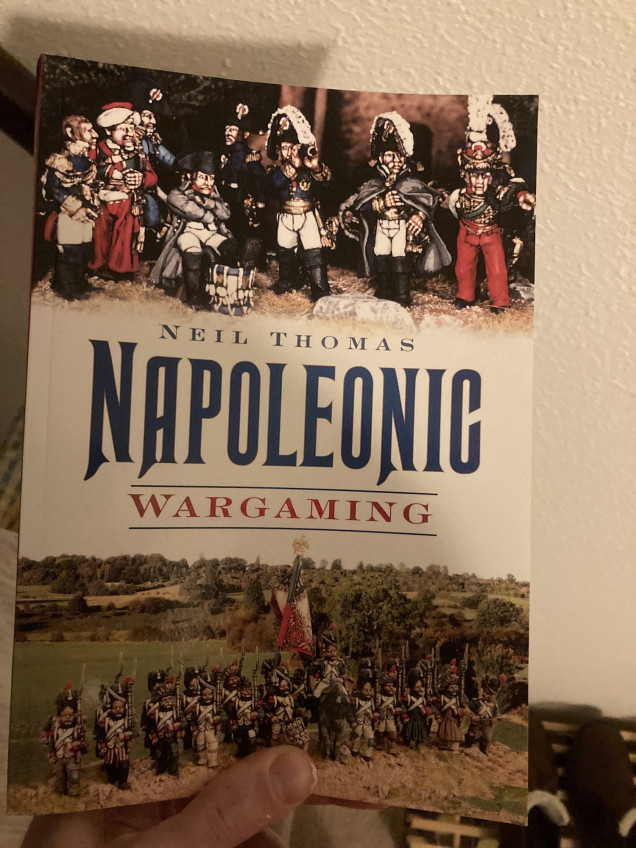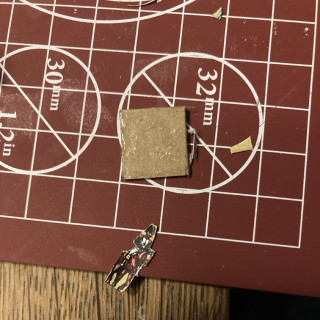
Dipping my toes into Napoleonics
First steps
One of the things that stopped me from committing to the Napoleonic itch until now, was that I couldn’t decide on a scale. To be honest, I am mostly drawn to 10mm, since that will give me a proper feeling for the battles of the era. But I also thought I should wait to see what scale others play in my area. Well, I haven’t found any others yet, but I’m done waiting!
Some might wonder why not get into it using a small-scale system like Silver Bayonet or Chosen Men: well, however cool they seem, I’m a bit tired of skirmish games. For a change I’d like to build a proper army again!
So, how to try out Napoleonics, but at a large scale? YES: paper miniatures! I got a set of Russian and French tiny fighting men plus some terrain from Peter’s Paper Boys, which is not only dirt cheap, but also seems easier than assembling and painting figurines.
Looking at the pages upon pages of printed out miniatures I get excited, although I do feel like a lion staring at a herd of zebras: my head slightly hurts as it tries to figure out where one mini starts and the other ends. There are so many of them, with the same markings!
Peter (I assume that is his actual name) from Peter’s Paper Boys has a video on his website giving you tips on how to cut and glue the minis. That was very helpful and gave me enough courage to do a test unit.
After having cut out the individual ranks, I lightly ran a hobby knife through the middle, which gives you a very neat fold. I glued the two sides together using pritt stick, which worked very well. After drying, this gave a strong and thick piece of paper.
Having started cutting out the tiny men I noticed two things:
- It is easiest to cut them out using scissors (as per Peter’s suggestion). The hobby knife felt like a good choice, but took much longer. And boy, this is going to take loooooooong.
- My hand hurts from cutting. This is going to take loooooooooooo<ouch>oooong.
At this point I should perhaps indicate what ruleset I intend to use.
Napoleonic Wargaming by Neil Thomas was brought to my attention in a podcast episode on Napoleonic wargaming. (For those interested, the podcast series is called The Napoleonicist and even though it normally doesn’t deal with wargaming, it makes for a very interesting listen!)
The book feels like a complete introduction into – well – Napoleonic wargaming. The first part gives you the historic background: basically, how was war fought before the Napoleonic wars, what changed, why were they fought and where, etc.
The author then goes into Napoleonic wargame rules, a brief history, the pitfalls and ultimately what a ruleset should be like. This is where he presents a ruleset of his own. Before giving you the ruleset itself, he first explains why he made certain choices in creating these rules. The man seems to know his stuff!
Now, since this is my first forage into Napoleonic wargaming (and historical wargaming in general!), I have no comparison to make. Keeping in mind the discussion in the recent XLBS episode, the rules do seem to reflect the period: your units can assume various formations: line, attack column, square, and marching column. There are no points to buy your units. Instead, you are allowed to pick 8 units and some are obligatory, depending on the period and the army. I find this somewhat curious, but we’ll see how that works out!
In general, the rules are kept simple and seem easy to understand. I will find this out when I start playing. I’ll dive into them more once I get to that stage!
Enough writy writes. Some more pictures!
So, instead of using the printed grass, I thought: why not just base the cardboard with flock? The above is an officer, which I used to test this. He is so tiny!!
I was quite pleased with how it worked out, so I set out to assemble the first base of French line infantry.
I’m very pleased with the look of these. I need three more bases to complete my first unit of line infantry. Note that the officer has no effect on the battle: he is just there to show marching direction when your unit assumes column of line formation (which means they seem to move sideways), to differentiate them from a normal line formation.
I’m not sure about the glue that I used for the flock. Normally I’d use wood glue, but since I was using ‘universal hobby glue’ to attach the paper guys to the base anyway, I figured I’d use it for the flock as well. The glue dried unevenly, which meant that some parts of the base were already drying and didn’t stick to the flock. This means that you see shiny bits of glue coming through at certain angles.
I think I’ll try to stick the paper men down with the universal glue and use it to flock the space between the ranks. I’ll then glue the flock around it using wood glue. I’ll keep you posted with the results!
Now, to continue cutting out more men…

































![How To Paint Moonstone’s Nanny | Goblin King Games [7 Days Early Access]](https://images.beastsofwar.com/2024/12/3CU-Gobin-King-Games-Moonstone-Shades-Nanny-coverimage-225-127.jpg)















































Now you can see why I like WoFun, it’s to save me cutting out millions of tiny fighting mens
Yes, I do see. WoFun do look good, but it somehow feels like I might as well buy ‘proper’ minis then: for the price of WoFun’s Allies Artillery I’m able to print out two whole armies and terrain. That said, I’ll probably be eating those words in a few weeks time…
The original thin blue line.??
it doesn’t get any thinner xD
Looks great so far and looking forward to see how the project progress’s
If I might make a suggestion that I’ve read on other paper fugure sites that it might be worth investing in 3D artillery but still using the paper figures for crew
Are you using modge podge to glue the figures down and to make them more resilient?
Thanks! As for the artillery, Peter’s Paper Boys has both 2D cannons, as well as 3D folded paper versions (you can see them on one of the pictures: https://peterspaperboys.com/collections/10mm-napoleonics/products/french-russian-bundle-all-sheets). I was planning on making the 3D ones, but they look very finicky…
As for Modge Podge: had to look that up! No, I just glued both ends together with pritt stick and that already made them quite resilient. I glued them to the base with universal hobby glue (the stuff that created those annoying strains).